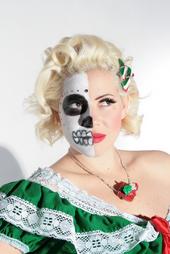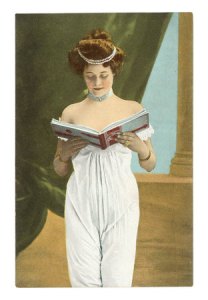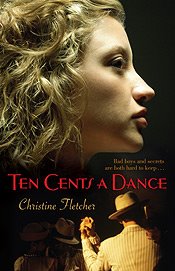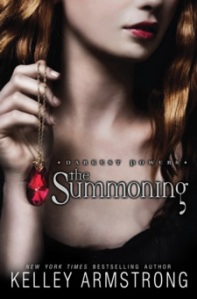 Photo by Brandon Showers
Photo by Brandon Showers
She lives on a quiet street in one of those indefinable parts of L.A., wedged between Hollywood and Silverlake. It took me two tries to find the address she’d texted me and just like a man, I was forced to call for directions. On the phone, La Cholita spoke with a youthful enthusiasm – not with an Eartha Kitt growl or a Mae West purr that one might expect upon seeing her photos.
When Cholita opened her front door, I was surprised to see that she wasn’t much taller than me. “You’re so tiny,” I couldn’t help but exclaim. She threw open her arms and she gave me a tight hug as if we were best friends who hadn’t seen each other since high school. She laughed. “I know. Everyone says that.”
La Cholita is not her creator, nor is she exactly an alter ego. (She also asked me not to use her real name to preserve her mystique and no, I didn’t make her up.) Cholita is an extension if you will, of the 25 year-old Latina who grew up in Highland Park watching musicals from the 1930s and 40’s. As we talked in her hot pink living room, I saw glimpses of the platinum blonde vamp in the happy, energetic woman with freckles under her make-up. It’s hard and yet, wasn’t hard to imagine her wowing audiences in a sparkling costume and leaving them wearing a g-string and pasties. But I got to know the the phenomenon known as La Cholita.
All I Need Is The Girl
Photo by Mr.40 Chev
 Six years ago, after her mom took her to a burlesque convention, La Cholita burst onto the L.A. scene as the first and only Latina dancer.
Six years ago, after her mom took her to a burlesque convention, La Cholita burst onto the L.A. scene as the first and only Latina dancer.
“I had a really hard time finding my way in,” she said. “It was like this secret society and when I’d ask friends who were doing it, they were very hush hush about how to get started.”
At that convention, she was dazzled by the burlesque queens, some who were still flashing their goods like they had when we were fighting the Nazis. Cholita’s only disappointment was that there were no Latinas.
“It seemed ridiculous to me because Latinas are the most sensual and passionate women in the world but we are also kind of conditioned to keep it all under wraps,” she said. “My disappointment quickly turned to enlightenment when I realized that’s it! This is what I am meant to do! All of those years singing, dancing and dressing up as a young girl was all in preparation for my ultimate calling: Burlesque Starlet.”
Cholita signed up for a burlesque class that again didn’t throw open the doors. But it did crack them open a little. All the students would have their chance to dance on-stage at The Derby in the retro-cool neighborhood of Los Feliz. Cholita realized everything was up to her – the choreography, costume and music – for her to stand-out among the veterans and new girls before a demanding audience.
“When my heel hit the stage, I knew it was right,” she said. “I couldn’t do anything else.”
The audience loved her and La Cholita, the burlesque starlet was born.
You Gotta Get A Gimmick
Photo by Mr.40 Chev
 La Cholita made her official debut as a Lowrider Loca wearing her name crystallized in Old English across her corset. She’s appeared with a Dia de Los Muertos calavera mask painted on half her face, as an Aztec goddess and in a folklorico dress from Chiapas. (My favorite are her beaded pasties of the Mexican flag.) At the end of each number, she throws up an East L.A. sign – her signature move – and has a loyal following of couples, Latinas and cholos and old pachucos who love her for representing la raza.
La Cholita made her official debut as a Lowrider Loca wearing her name crystallized in Old English across her corset. She’s appeared with a Dia de Los Muertos calavera mask painted on half her face, as an Aztec goddess and in a folklorico dress from Chiapas. (My favorite are her beaded pasties of the Mexican flag.) At the end of each number, she throws up an East L.A. sign – her signature move – and has a loyal following of couples, Latinas and cholos and old pachucos who love her for representing la raza.
But burlesque, with its roots in old school Hollywood glamor – many of the women boast looks clearly inspired by Rita Hayworth, Marilyn Monroe and Jean Harlow – cast La Cholita as one of the bad girls.
“Some of the other dancers told me that my image wasn’t sexy, that the street element was too tough and my energy was too intense,” she remembers. “At first I felt bad but then I remembered that the reason I started was because I wanted to be different, I wanted girls to feel inspired, I wanted to represent a strong Latina and show that our curves are something to be proud of, that our culture is something to be proud of.”
Since then La Cholita has performed around the world, winning the coveted Miss Viva Las Vegas title in 2007 and appearing on Carson Kressley’s “How to Look Good Naked”, Telemundo and Eyewitness News. She’s danced for corporate clients Hornitos, Christina Aguilera and European surgeons. She now models for ChicanaWear Clothing, La Pachuca, Secrets in Lace, Stop Staring, Dainty Dames, Ignition, and My Lucky Girls Creations.
“I knew girls who gave up because they couldn’t make ends meet,” she said. “There were times when I was almost evicted and lost my power or water and had to hide my car from being repossessed. But I wouldn’t give up.”
Little Lamb
Photo by Mr.40 Chev
 “I’ve always been an outsider,” Cholita said. “My childhood wasn’t all rainbows and lollipops.”
“I’ve always been an outsider,” Cholita said. “My childhood wasn’t all rainbows and lollipops.”
When she was grew up with her single, artist mom in Highland Park. She wasn’t brown enough for the chicano kids in her neighborhood, nor could she relate to the privileged kids in the private prep schools her mom enrolled her in. She didn’t form a relationship with her father until she was fourteen and he was dying of cancer.
“I was really awkward and I’d come home crying that I hated my chubby legs, curly hair and freckles and that I hated my mom for giving them to me.”
Cholita escaped her self-loathing through dance and acting lessons her mom scrapped to provide, and through the glamor of old movies. And yet, she was fascinated by the cholas she’d see hanging in her neighborhood and at the car shows where her uncles would proudly show off their lowriders.
“I remember seeing cholas on the street corners with their crazy nails and their hair teased and just that opulent, over-the-top look,” she said. “And yet, they were tough.”
Her grandfather, a zoot suiter from the ’40s, also had an influence on her developing style. “He’d tell me all kinds of stories probably because I was the only person who listened to him. He used to tell me you could get into a fight or kill a man but you looked good doing it.”
She laughed and shook her head. “He always said in his day you had to represent.” She then mimicked him. “Cholos nowadays, they don’t got no style. In my day, I’d fuck a man up and still had a crease in my pants.”
He passed away last November and Cholita occasionally had to buck up when she talked of him.
“My biggest validation was when he came to my shows,” she said. “He really said he loved it.”
Some People
Photo by Mr.40 Chev
 La Cholita not only dresses the part of the “fuck-you-up” chola, she also lived the life. In high school, she began running with gangsters and dabbling in drugs. When she started to see her friends getting shot and dying, she knew she had to get out of the life if she wanted to live.
La Cholita not only dresses the part of the “fuck-you-up” chola, she also lived the life. In high school, she began running with gangsters and dabbling in drugs. When she started to see her friends getting shot and dying, she knew she had to get out of the life if she wanted to live.
“I weighed 98 pounds and when I look at my high school prom pictures-” She sucked in her breath. “I was barely there.”
Her mother taking her to the burlesque convention seemed to have opened an escape hatch.
“I was a 180 pounds when I started [dancing] and I’ve never felt more secure and more empowered.” Even though she’s getting naked before strangers on bars and theatre stages, the burlesque style of stripping is all on the dancer’s terms.
“I decide what people see and what they don’t,” she said. “What I thought was my flaws are what make me stand out.”
Ironically, corsets and fishnets are in her blood. Her grandmother on her father’s side was once a burlesque dancer.
“When [that side of the family] found out what I was doing, they-” she makes a slicing motion through the air. “They cut me off.”
Let Me Entertain You
Photo from Miss Viva Las Vegas Competition 2007
 La Cholita’s L.A. appearances are family affairs with her mom, tios, tias, cousins and friends cheering her on. She’s backed by her own band and her fans come dressed to the nines to see her. Men treat her like a lady when they approach her after her performances. “I’ve never been treated more respectfully than ever in my life,” she says.
La Cholita’s L.A. appearances are family affairs with her mom, tios, tias, cousins and friends cheering her on. She’s backed by her own band and her fans come dressed to the nines to see her. Men treat her like a lady when they approach her after her performances. “I’ve never been treated more respectfully than ever in my life,” she says.
She has driven audiences into ecstasy just by taking off a glove. At a performance at the Hard Rock Hotel in Las Vegas, she sent an elderly man to the hospital. Her friend once told her that she’s a force on stage.
“Every single time I’m standing in the wings, I’m nervous. I can barely hold it in. It’s like I’m being electrocuted in the inside,” she said.
As Cholita she doesn’t feel intimidated about anything. She can approach a cute guy and ask him out. The second her music comes on and she steps out under the lights, something takes over her. She doesn’t think about the moves. She gets off on the energy, feeding it and feeding off of it. She loves that she never knows what’s going to happen and that no number is ever the same as the last.
But in more intimate situations, when she’s with a guy, she admits, “I’m thinking, ‘oh now I have to take off my bra’ … ‘is the light hiding my cellulite from him?'” We laughed; I’m relieved that I have the same hang-ups as a woman who seduces audiences for a living.
“I’m more vulnerable as myself,” she said.
La Cholita sees no limit to the possibilities. She sees designing a line of clothing, creating her own one-woman show and modeling. Her dream is to dance in Paris and tour Mexico, especially to perform on the stage of the Juarez theatre in Guanajuato, where she visited with her grandfather.
“I’m not ready for that,” she said, pausing to think about returning to that theatre without him. “I am following my dreams, making things happen and representing where I’ve come from. I am very lucky and ever so grateful to have the support of mi familia.”
To see the complete gallery of La Cholita’s photos, her schedule of performances and more, visit her at VivaCholita.
Contest!
Sherri won Berta Platas’ drawing from yesterday’s blog … hurray!
The winner of my contest is Teresa Carbajal Ravet! Thanks EVERYONE for reading and getting to know La Cholita!




















